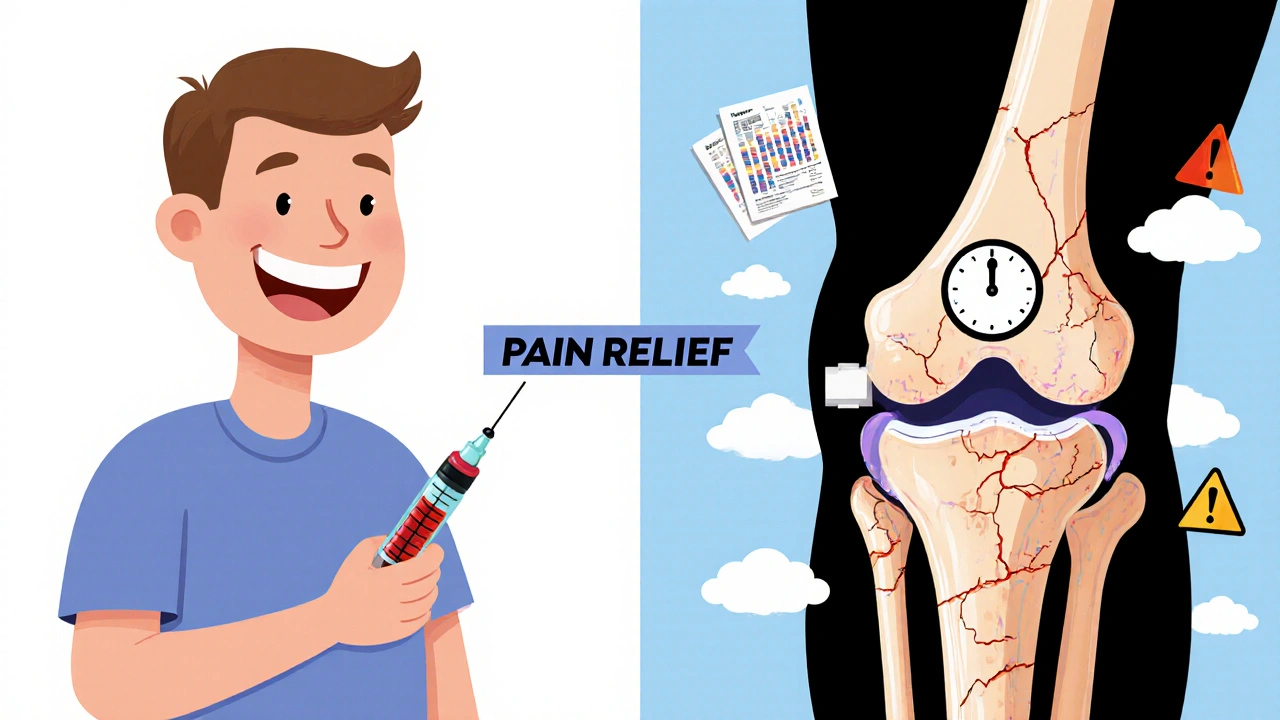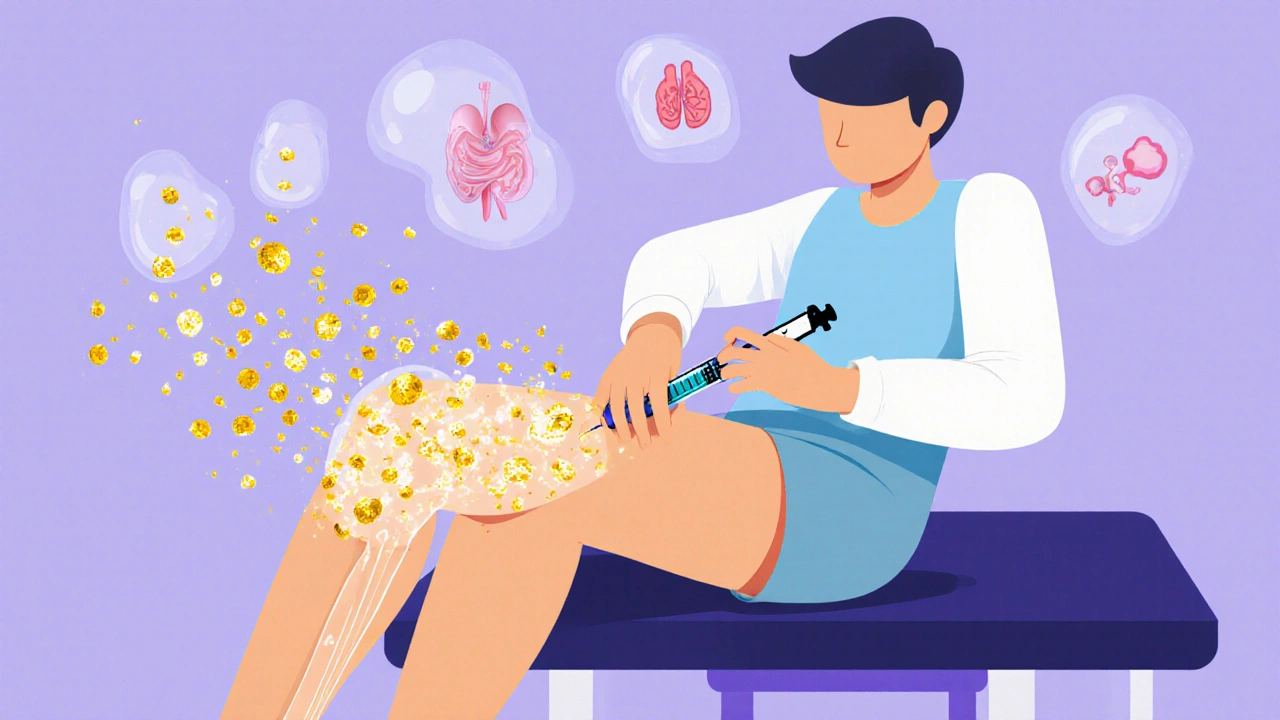Steroid Injection Safety Calculator
Joint Injection Safety Assessment
Based on guidelines from the article, this tool helps determine your risk threshold for intra-articular steroid injections.
Important: According to the article, most guidelines recommend no more than 3-4 injections per joint per year. Some clinics cap it at 2. If you've had 3 shots in 6 months and your pain persists, it's time to rethink your plan.
What Are Intra-Articular Steroid Injections?
When your knee, hip, or shoulder hurts from arthritis, your doctor might suggest an intra-articular steroid injection. It’s a quick shot of corticosteroid medicine directly into the joint. The goal? Reduce swelling and pain fast-often within days. This isn’t new. Doctors have been using these injections since the 1950s, after Nobel Prize-winning research showed cortisone could calm inflamed joints.
Today, about 12 million of these shots are given in the U.S. every year. They’re common because they work. For many people, a single injection means weeks or months of better movement and less pain. But here’s what most patients aren’t told: even though the medicine goes straight into the joint, it doesn’t stay there.
How Do These Injections Affect the Whole Body?
It’s easy to assume that if the needle goes into your knee, only your knee gets affected. But that’s not true. Corticosteroids like triamcinolone acetonide and methylprednisolone can leak out of the joint into your bloodstream. Once in the blood, they act like oral steroids-just slower.
Studies show that even a single injection can cause temporary spikes in blood sugar. If you have diabetes, your levels might stay elevated for days. That’s not just inconvenient-it can mess with your long-term control. One study found that patients with type 2 diabetes had a 30% higher chance of needing insulin adjustments after a joint shot.
And it doesn’t stop there. These steroids can suppress your adrenal glands. Your body naturally makes cortisol, a hormone that helps manage stress, blood pressure, and metabolism. When you get repeated steroid injections, your body thinks, "Hey, we don’t need to make our own anymore," and slows down production. For some, this leads to adrenal insufficiency-where your body can’t respond to physical stress like infection or injury. That’s dangerous.
Other systemic effects? High blood pressure, fluid retention, facial flushing, and mood swings. Even something as odd as a temporary change in taste has been reported. These aren’t rare side effects. They’re expected with frequent use.
Are These Injections Damaging Your Joints?
For years, we were told: "These shots won’t hurt your joint-they just help." But new research is turning that idea upside down.
A major 2023 study in Radiology followed over 1,000 patients who got corticosteroid injections in their hips or knees. The results were startling. Patients who got injections showed faster joint space narrowing-meaning the cushion between bones was wearing away quicker. Some lost 2 mm of joint space in just 12 months. That’s the kind of damage you’d normally see over five years in untreated osteoarthritis.
And it’s not just cartilage. Researchers found higher rates of:
- Subchondral insufficiency fractures-tiny cracks under the joint surface
- Osteonecrosis-bone tissue dying because blood flow gets cut off
- Rapid progressive joint destruction
One in 100 patients developed one of these serious complications. That’s low, but not negligible. And here’s the kicker: the risk went up sharply for people who got more than two injections a year.
Another study from the Osteoarthritis Initiative found that people who got repeated knee injections had 4.67 times higher odds of radiographic worsening compared to those who didn’t get any. Even if you feel better after the shot, your joint might be quietly falling apart.

What Do Experts Really Think?
There’s no consensus. Some doctors still swear by these injections. The American Academy of Orthopaedic Surgeons still conditionally recommends them for knee osteoarthritis. The American Family Physician journal says benefits usually outweigh risks.
But a growing group of experts are sounding alarms. Dr. Ali Guermazi, a leading radiologist at Boston University, put it bluntly: "We’ve been telling patients that even if these injections don’t relieve your pain, they’re not going to hurt you. But now we suspect that this is not necessarily the case."
Here’s the real problem: many people getting these shots don’t have severe arthritis. They have mild pain, or their X-rays show little damage. That’s when the risk-benefit balance flips. If your joint isn’t badly worn out, why risk accelerating the damage? You might be trading short-term relief for long-term surgery.
Some studies contradict this. One trial by Dr. Raynauld found no joint space narrowing after steroid injections. Another showed cartilage loss on MRI but no bone damage. The science isn’t perfect. But the trend is clear: repeated injections, especially in younger patients or those with early-stage disease, carry hidden dangers.
When Are These Injections Still Worth It?
That’s the million-dollar question. They’re not all bad. For someone with a sudden flare-up of gout or rheumatoid arthritis, a steroid shot can be life-changing. For an older adult with severe osteoarthritis who’s not a candidate for surgery, it might be the best option for staying mobile.
But here’s how to think about it:
- Use it as a bridge, not a bandage. If you need more than two injections a year in the same joint, something else is wrong.
- Don’t use it for mild pain. If your X-ray looks nearly normal, the pain might be coming from something else-muscle imbalance, nerve irritation, inflammation elsewhere.
- Avoid it if you have diabetes, osteoporosis, or are planning joint surgery soon.
- Never use it as a substitute for physical therapy, weight management, or activity modification.
There’s no magic number of safe shots. But most guidelines agree: no more than 3 to 4 per joint per year. Some clinics cap it at 2. And if you’ve had three shots in six months and your pain is still bad? It’s time to rethink your plan.

What Are the Alternatives?
If you’re worried about steroids, you’re not alone. More people are asking: "What else works?"
Physical therapy is the strongest alternative. Studies show it’s as effective as steroid injections for knee osteoarthritis-and it doesn’t damage your joint. Strengthening muscles around the joint reduces pressure on cartilage. It’s slow, but it lasts.
Weight loss is another powerful tool. Losing just 5% of your body weight can cut knee pain by 50%. That’s better than any shot.
Newer options are emerging. Hyaluronic acid injections (viscosupplementation) are still debated, but they don’t carry the same systemic risks. Platelet-rich plasma (PRP) and stem cell therapies are being studied, though they’re expensive and not yet covered by insurance.
Even simple things like walking, using a cane, or wearing supportive shoes can make a big difference. The goal isn’t just to mask pain-it’s to protect your joint for the long haul.
What Should You Ask Your Doctor?
Before you say yes to a steroid injection, ask these questions:
- "Is my pain really coming from the joint, or could it be something else?"
- "What do my X-rays or MRI show? Are there signs of early damage?"
- "How many injections have I had in this joint already?"
- "What happens if this shot doesn’t work-or makes things worse?"
- "What are my non-injection options?"
Don’t be afraid to push back. You’re not just getting a shot. You’re making a decision about your joint’s future.
Bottom Line
Intra-articular steroid injections aren’t evil. They’re a tool. But like any tool, they can cause harm if used carelessly. The biggest risk isn’t infection or a bad reaction-it’s the quiet, slow destruction of your joint that no one talks about until it’s too late.
If you’re young, active, or have early arthritis, think twice. If you’re older, have severe pain, and have run out of other options, it might still be worth it. But always ask: is this helping me now-or hurting me later?
The truth? There’s no safe number of steroid shots. Only smart decisions.

